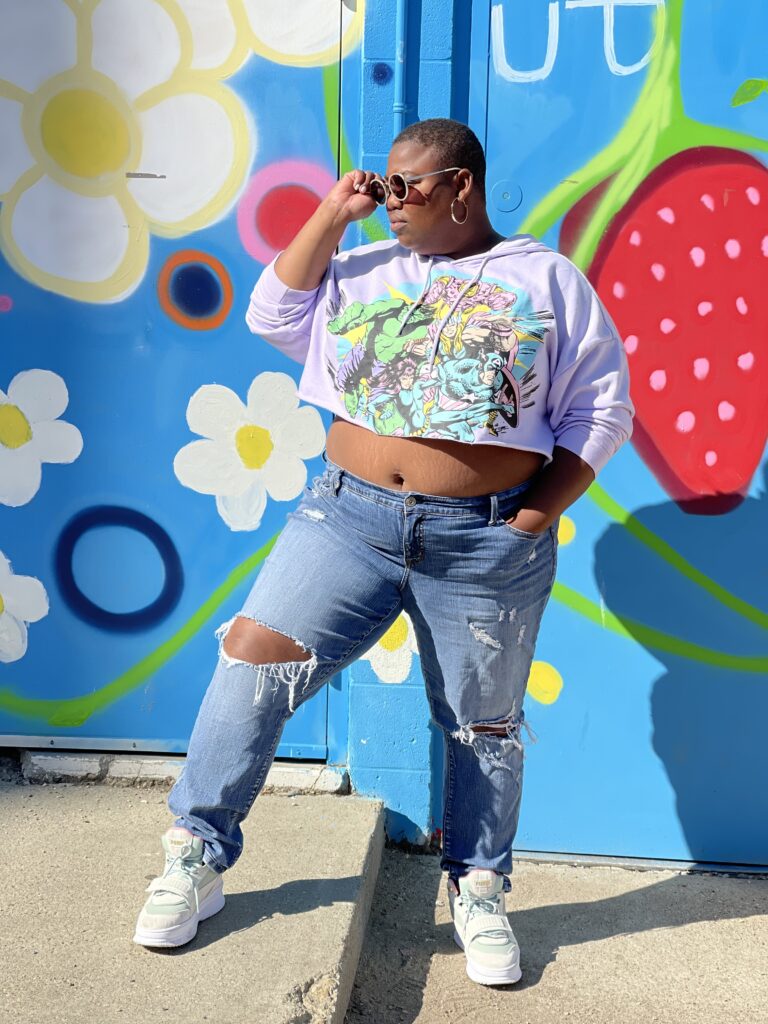Shared from www.chatelaine.com
(Photo: London Blackwood)
Sheila Wenham bought her first vintage piece, a pink fit-and-flare dress, for only $14 when she was in high school. She was amazed at how inexpensive it was to buy used clothing. “I was like, ‘Second-hand is the way to go!’” she remembers.
Today, Wenham’s closet in Victoria is filled with second-hand clothing. Years of perusing the racks at thrift shops have made her an expert at finding high-quality vintage and designer pieces, which she models on her blog Ephemera, and she often brings friends to thrift shops to teach them how to find good pieces.
The fashion industry accounts for 10 percent of global carbon emissions, and producing a single pair of jeans generates 11 kilograms of carbon dioxide. With concerns about sustainability rising, many in Canada are turning to thrift shopping as a more eco-friendly alternative to buying new clothes.
But stepping into a thrift store can be overwhelming. Here’s what you should know before you face the racks of clothes at your local second-hand store.

(Photo: Sheila Wenham)
Start with accessories
Wenham says the easiest way to get your feet wet in the thrifting world is to check out the accessories section. Purses, belts and hats are often inexpensive compared to clothing, and it’s less time-consuming to peruse those sections because fit isn’t as much of an issue. Make sure that the accessories you’ve chosen are in good condition. “Give them a shake,” Wenham says. If trimmings, fluff, leather rot or other odds and ends fall off, put them back.
Check the measurements
Last year, London Blackwood and their partner started Chubby Fem Thrift, an online thrift store based in Edmonton that provides second-hand pieces to the plus-sized community, who are frequently excluded from mainstream fashion. They emphasize to their customers that different brands size their clothes differently, and the dimensions of the garment may be different from what you’re expecting. “Start with your typical size,” they advise. “So if you are usually an extra large, go there first, but make sure you’re checking the measurements.” Older garments also tend to have different sizing from modern clothing, and items in thrift stores can be mislabelled, so don’t be afraid to stray from your usual size. Even items that aren’t quite your size can be tailored to fit.
Amid the pandemic, many clothing and thrift stores have closed their changing rooms, making it difficult to know whether a piece will fit you. Julie Ethier, who resells thrifted clothing at Sick Jacket Vintage in Edmonton, says the easiest way to avoid this problem is to bring a measuring tape. “Measure your favourite pieces. If you have a sweater that you really, really love, take a measurement,” she says. Measure different parts of the garment, like the chest and waist, so that when you’re at the thrift store you can whip out your measuring tape and check if a piece will fit you or not. For skirts and pants, wrapping the garment’s waist around your neck can also be a handy size check—items that fit comfortably and snugly around your neck will fit similarly around your waist.
Check the tags
The second-hand clothes in Ethier’s closet are mostly vintage pieces that are a few decades old. “If they’ve already lasted 40 or 50 years, the chances are they’re going to last you a lot longer too,” she says. Checking the tags can show you whether a piece has already weathered a couple of decades. Brands with a long history, like Nike, will have changed their tag styles and logo over the years, so if you recognize the brand but not the tag, that’s a good indicator that it’s vintage. In addition, tags will often tell you what fibres the garment is made from. Ethier says to avoid synthetic fibres like polyester and acrylic. She prefers to buy and resell clothing made from natural fibres like wool, cotton or silk—thrifting experience can help you identify these by touch. “They last a long time, they don’t pill as much. They’re just really good quality,” she says.
Check for damage and be ready to repair
When Wenham finds a piece she likes, she’ll run the zipper up and down a few times to make sure it’s working properly. She suggests checking the fabric at the bottom of the zipper to ensure it’s not ripped. She also looks for moth holes, which are usually deal breakers for her. “Put your hand in, stretch out the sleeve, hold it up to the light. The holes will pop right out at you,” she says.
For Angel Time, who resells thrifted clothing on Instagram, checking the seams of a garment is essential. “I look at the stitching: if it’s well stitched, if it’s tight, if it’s still intact,” they say. Overall, they say a piece is good quality if it maintains the integrity of its original design, including its original colour and shape.
Suzanne Carillo, a style blogger and vintage reseller in Toronto, says the more she thrifted the more she started to see what she could do with even damaged or dirty pieces. She says washing items with vinegar or baking soda can help to get rid of the unwashed “thrift store smell”—items that shouldn’t be washed can be hung out in the sun or placed in a bag in the freezer. Stains in silk and satin, as well as armpit and rust stains, can be difficult to remove. But she says soaking most fabrics in hot water with powdered OxiClean should take out other stains. You can soak clothing for up to two weeks, although she recommends keeping an eye on it to ensure the solution doesn’t take the dye out with the stain. If that doesn’t work, or you’re reluctant to risk the dye, she says you can find different stain removal recipes online to experiment with.
Ethier says almost all damage on thrifted items is repairable if you’re willing to put in the work. Thrifting isn’t reserved for those who are good at sewing and repairing, she says. “If you can’t do it yourself, just bring it to your local tailor and they can make magic happen.”
Take your time
Blackwood says one of the most difficult parts of thrifting is finding the time to sift through mountains of clothing. “It’s really time consuming to find the perfect piece,” they say. When they first started thrifting, they would set aside hours to look through all the pieces, but they say spending that time looking is worth it. “There’s usually a gem that you find in the massive amounts of clothes that are at the thrift store,” they say.
If you’re not inclined to spend hours in a thrift store, look no further than your computer or phone. Smaller thrift resellers will often set up shop on Etsy or Depop, or even Instagram. Larger sellers, like Blackwood’s Chubby Fem Thrift or Ethier’s Sick Jacket, will often have their own website.
If you’d like to go in-person thrifting, though, Wenham says it’s important to plan to spend more time in a thrift store than you would in a new clothes store. “Anything that you really want to do, that matters to you, is going to take time and effort,” she says.
Images and Article from www.chatelaine.com

